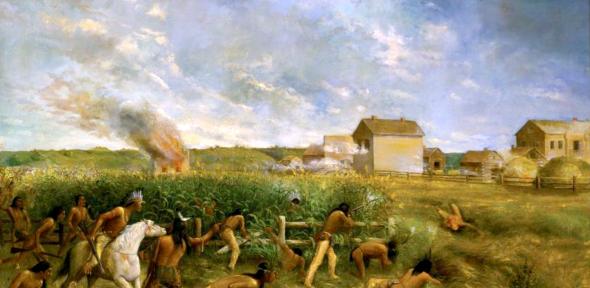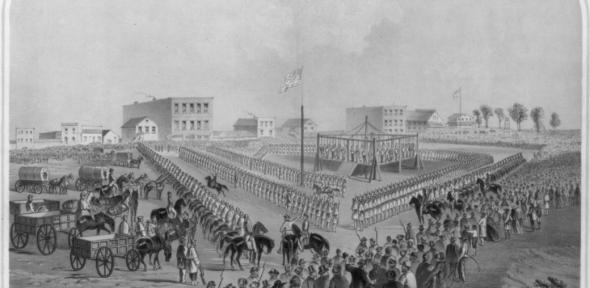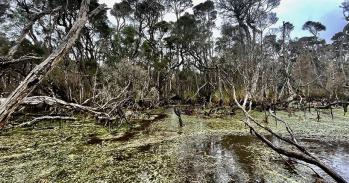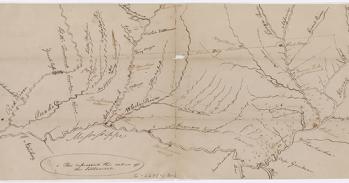
The story of Native North America – from its vast contribution to world culture, to the often taboo social problems of drinking, gambling and violence – is the subject of a sweeping new history by a Cambridge academic and authority on the subject.
The story of Native North America – from its vast contribution to world culture, to the often taboo social problems of drinking, gambling and violence – is the subject of a sweeping new history by a Cambridge academic and authority on the subject.
No understanding of the USA is possible without first comprehending the story of its original inhabitants.
Jonathan King
Blood and Land by Jonathan King, the Von Hügel Fellow at the Museum of Archaeology and Anthropology, is the story of how Native North America has shaped the United States and Canada, and vice versa.
The product of decades of study, Blood and Land seeks to move beyond the traditional ‘feathers-and-failure’ narrative to interrogate the myriad and multi-layered histories of North America. King takes an unflinching look at the many successes, desperate struggles and threats to the very existence of Native populations.
“So much of what we know about America today is tied up in its history and treatment of Native North Americans over the last few centuries,” said King. “No understanding of the USA is possible without first comprehending the story of its original inhabitants.
“My book provides a different perspective. General histories are often presented as a progressive fall from grace. But the true story is actually one of how Indian people continually recovered and made the country their own again, whether that is through the growth of casinos or mineral exploitation. Each time recovery occurs, new difficulties emerge to threaten the status quo.
“When you look at the challenges Native Americans have faced over time – right through to Eisenhower trying to legislate them out of existence, and the forced sterilisation of Indian women in the 1970s – Native Americans are not only surviving, but thriving as a phenomenon in both the imagination and the intellect. In the early part of the 20th century, very few wanted to be identified as Native American. Now, there is something of a clamour to identify Native blood in one’s family tree, often met with disbelief. Look at Senator Elizabeth Warren, whose early intimation of Cherokee ancestry was met with derision.”
However, Native populations still face many of the struggles connected with racism, poverty and access to the same life chances as non-native populations.
One remarkable example of the ‘otherness’ still ascribed to Native peoples came in 2011 when the War on Terror was compared, by a legal representative of the United States Government, to the early 19th century wars on Indian nations.
In a case against a Guantanamo Bay suspect, United States vs Al Bahlul, it was said that the trial and summary execution by General Andrew Jackson of two Scots in Spanish Florida in 1818, traders with the Seminole, was legal and correct and provided precedent for contemporary behaviour by the USA in the war against Al-Qaeda. The Scottish traders had been providing weapons to terrorists. In a non-ironic manner, the Seminole were themselves compared to Al-Qaeda.
The National Congress of American Indians took exception to the comparison, pointing out that Seminole efforts to defend themselves from an invading genocidal army could be termed as ‘unlawful belligerency’ by only the most jingoistic military historian.
“The case sought to use genocide as a justification for misbehaviour in the wider world in the 21st century,” said King. “It was that same US strategy and behaviour against Indian nations that helped determine US behaviour in dealing with 21st century terrorism. Specifically obnoxious to Native people in 2011 was the fact there were around 24,000 Indian people serving in the military that year, and approximately 383,000 American Indian veterans.”
That there are so many veterans is testament to the 20th century recovery in fortunes that King frequently refers to in Blood and Land. In 1900, there were just 237,196 Indians. In 2010, 5.2 million people recorded themselves as American Indian and Native Alaskans, 1.7pc of the total US population, with an expectation of growth to 8.6 million by 2050 (2pc of the total projected population). In 2010 there were more than 15 states with more than 100,000 American Indian or American Native people, with California (732,225) leading the way.
In Canada, 1.4 million people identified as Aboriginal in 2011, some 4pc of the population. In 1900 that number was thought to be around 100,000. However, compared to a map of the USA’s settlements, the size and scale of Canadian First Nations’ reserves appears to make a much, much smaller footprint on the map of Canada. Outside of the north they have remained just ‘small dots on the map’ according to King.
The growing strength of Native America has also been symbolised by the removal of racist sporting logos in the last few decades with one major exception: the Washington Redskins have steadfastly stuck to a name considered derogatory by many.
While King rightly points to the many success stories for Native Americans in the 20th century, he does not shy away from tackling subjects such as alcohol abuse and gender violence that are often swept under the carpet by communities and commentators alike in the US.
Although problems with alcohol and substance abuse are well-known if not well discussed, the role of gambling in Indian life – both as a profit-making business enterprise and a social ill for Native communities – has been more visible. Today, Indian gaming is responsible for nearly 612,000 jobs worth more than $27.6 billion. It is estimated that almost half of America’s native tribes operate casinos despite some studies suggesting that the immense tribal gaming revenues can actually make poverty worse in their local communities.
However, although King argues that casinos have largely been a force for good, he does believe gambling in reservation casinos may have reached its high water mark. Beyond casinos he also warns of the impact of declining natural resources and climate change.
“Casinos should not be seen as a blight, even if gambling can be seen as a highly destructive vehicle of achievement,” added King. “They have provided wealth and income to communities on an incredible scale, and much gambling wealth has been put into providing police forces, schools and hospitals. But this decade is likely to be the climax of Indian gambling. What will happen when these casinos disappear in favour of online gambling which is accessible without the need to travel?
“However, the long centuries of change for Native people have resulted in a resilience that ensures survival. This in part is to do with the uniqueness and hyper-diversity of Indian culture, its ability to recreate and rethink identity and circumstance, architecture and art; but it is also to do with the way in which Nativeness is embedded in the United States and Canada.
“Indians are unique in their contribution to world history. Whether it be kayaking, canoeing, snow- shoeing or lacrosse, Blood and Land repeatedly outlines the innovation of Indian society and its huge contribution to global culture, far outweighing the number of Native people there are today. That is the truest measure of their success.”

The text in this work is licensed under a Creative Commons Attribution 4.0 International License. For image use please see separate credits above.
















